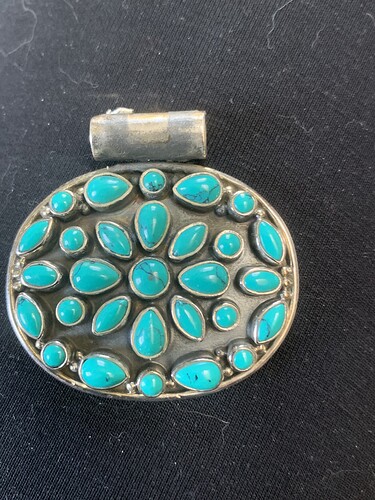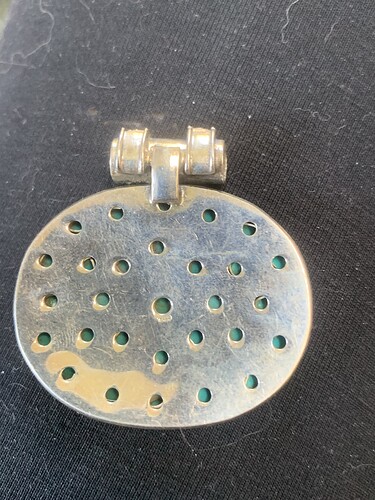I got this in an auction, and there was only a front pic. The back is weird! I just opened the package and not only are there holes behind the (very pretty color) stones, but it seems to have been cut (badly) off something else. No stamps.
Your thoughts?
I would guess not Native American.
The pendant looks like it was severed from a larger piece and has an Asian look to me, especially the bezel settings. What looks like a tiny 925 (partially destroyed by the hole) is similar to what I see on Asian items.
Thank you!! I will be returning it…,![]()
![]()
Agree it’s got Nepali vibes. Sorry for your disappointment.
I wouldn’t assign this piece to an offshore origin. Those bezels are pretty good, they took some time to create. Bezels need a bit of clean up, but not bad; the maker used a heavier gauge silver than the ubiquitous flimsy commercial bezel wire. I bet this was student work, taught to use the heavy bezel and hammer the silver down over the stone (rather than a quick push over), and someone told them to drill the holes in the back to either push the stones out in case the stones got stuck in the fitting or to let the light through- not considering the stones would be turquoise.
Respectfully disagree. The bale is a pretty clear tell of Nepal/Tibet work, as is the oddball (by Native standards) arrangement of applied raindrops. The reverse is aesthetically bananas, again by US Native standards; wouldn’t Native jeweler education involve aesthetics?
I always think we shouldn’t have to talk ourselves into being able to see the Native American person’s hand and mindset in the work.
This: “Respectfully disagree. The bale is a pretty clear tell of Nepal/Tibet work”
Tibetan ![]()
I didn’t say it was NA, nor did I intend to infer that. It looks like a piece you see in a jewelry school studio made by a student / new metalsmith. Those bezels take considerable time, effort and material to make, and what is being interpreted as raindrops are just silver balls or “granulation” to non NA makers (and lots of new jewelry makers use silver balls to fill odd spaces). I have a stash of my student work and it’s cringe worthy: funky bails, silver balls, unsuccessful “fixes”, weird holes…
You make an excellent point @chicfarmer. I have seen this in many many areas. “Perception is reality” as a generality and not as it applies specifically here. Just making a point. One of the early things you learn about law is “read what the law says, not what you think it says or want it to say”. I try to apply that initial objectivity when observing jewelry as well. A piece will stand on its own one way or another when compared against similar and dissimilar items.
I guess my comment was about not falling prey to wishing vs. understanding what we’re buying when the goal is to acquire Native-made work. It goes back to something I learned early on from a mentor, to pay attention when something just seems a little too off: respect that sensation and let it alone. Something can be objectively “good” or well done, but if the goal is building a NA collection, that’s not helpful. Objects do speak, and we need to listen.
Understood. I think we are on parallel tracks with different reference points.
This an interesting discussion to me. I don’t have any experience silver working myself except for a terribly failed Thunderbird bracelet I attempted as a teen. I can appreciate an expertly made piece, and you’re right, this isn’t one. Whoever made it. There are some good bits. But overall it’s not great.
I really appreciate you all taking the time to check it out and help me learn!
Thanks so much!!
to me, these look like calibrated dyed howlite and premade bezel cups.


